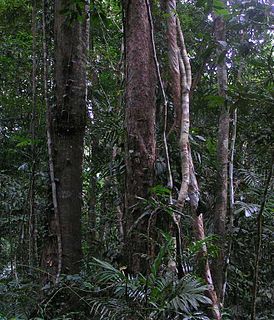 W
WForest ecology is the scientific study of the interrelated patterns, processes, flora, fauna and ecosystems in forests. The management of forests is known as forestry, silviculture, and forest management. A forest ecosystem is a natural woodland unit consisting of all plants, animals and micro-organisms in that area functioning together with all of the non-living physical (abiotic) factors of the environment. The forest ecosystem is very important.
 W
WAfforestation is the establishment of a forest or stand of trees (forestation) in an area where there was no previous tree cover.
 W
WAssisted natural regeneration (ANR) is the human protection and preservation of natural tree seedlings in forested areas. Seedlings are, in particular, protected from undergrowth and extremely flammable plants such as Imperata grass. In addition to protection efforts, new trees are planted when needed or wanted. With ANR, forests grow faster than they would naturally, resulting in a significant contribution to carbon sequestration efforts. It also serves as a cheaper alternative to reforestation due to decreased nursery needs.
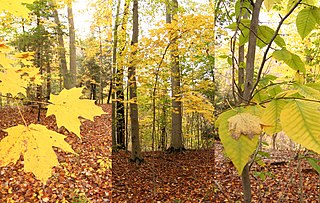 W
WA beech–maple forest or a maple beech forest is a climax mesic closed canopy hardwood forest. It is primarily composed of American beech and sugar maple trees which co-dominate the forest and which are the pinnacle of plant succession in their range. A form of this forest was the most common forest type in the Northeastern United States when it was settled by Europeans and remains widespread but scattered today.
 W
WThe Bottomland hardwood forest is a type of deciduous and evergreen hardwood forest found in US broad lowland floodplains along large rivers and lakes. They are occasionally flooded, which builds up the alluvial soils required for the gum, oak and bald cypress trees that typically grow in this type of biome. The trees often develop unique characteristics to allow submergence, including cypress knees and fluted trunks, but can not survive continuous flooding.
 W
WIn biology, the canopy is the aboveground portion of a plant croping or crop, formed by the collection of individual plant crowns.
 W
WCanopy interception is the rainfall that is intercepted by the canopy of a tree and successively evaporates from the leaves. Precipitation that is not intercepted will fall as throughfall or stemflow on the forest floor.
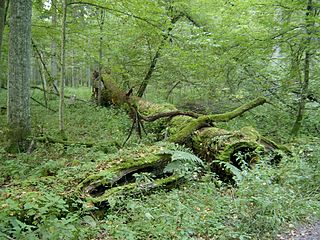 W
WCoarse woody debris (CWD) or coarse woody habitat (CWH) refers to fallen dead trees and the remains of large branches on the ground in forests and in rivers or wetlands. A dead standing tree – known as a snag – provides many of the same functions as coarse woody debris. The minimum size required for woody debris to be defined as "coarse" varies by author, ranging from 2.5–20 cm (1–8 in) in diameter.
 W
WIn the central and southern Appalachian Mountains of Eastern North America, a cove is a small valley between two ridge lines that is closed at one or both ends.
 W
WCrown closure is a term used in forestry. Crown closure and crown cover are two slightly different measures of the forest canopy and that determine the amount of light able to penetrate to the forest floor.
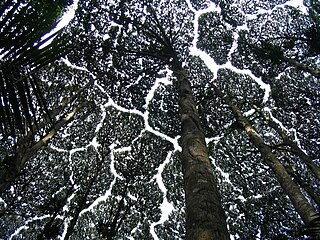 W
WCrown shyness is a phenomenon observed in some tree species, in which the crowns of fully stocked trees do not touch each other, forming a canopy with channel-like gaps. The phenomenon is most prevalent among trees of the same species, but also occurs between trees of different species. There exist many hypotheses as to why crown shyness is an adaptive behavior, and research suggests that it might inhibit spread of leaf-eating insect larvae.
 W
WIn myrmecology and forest ecology, a devil's garden is a large stand of trees in the Amazon rainforest consisting of at most three tree species and the ant Myrmelachista schumanni. Devil's gardens can reach up to sizes of 600 trees and are inhabited by a single ant colony, containing up to 3 million workers and 15,000 queens. In a 2002 to 2004 census of the Amazon, devil's gardens were shown to have grown by 0.7 percent per year. The relationship between tree and ant may persist for more than 800 years. A devil's garden is considered an example of mutualism, a type of symbiotic relationship between species.
 W
WEcological thinning is a silvicultural technique used in forest management that involves cutting trees to improve functions of a forest other than timber production.
 W
WThe exceptional forest ecosystems of Quebec are stands of trees of outstanding interest for biodiversity that should be preserved for future generations. They are protected by the Ministry of Natural Resources and Wildlife of Quebec
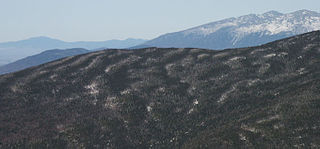 W
WA fir wave is a set of alternating bands of fir trees in sequential stages of development, observed in forests on exposed mountain slopes in several areas, including northeastern North America and Japan. Fir waves develop by wave-regeneration following wind disturbance, and is one of various types of patterned vegetation.
 W
WFire ecology is a scientific discipline concerned with natural processes involving fire in an ecosystem and the ecological effects, the interactions between fire and the abiotic and biotic components of an ecosystem, and the role as an ecosystem process. Many ecosystems, particularly prairie, savanna, chaparral and coniferous forests, have evolved with fire as an essential contributor to habitat vitality and renewal. Many plant species in fire-affected environments require fire to germinate, establish, or to reproduce. Wildfire suppression not only eliminates these species, but also the animals that depend upon them.
 W
WPyrogeography is the study of the past, present, and projected distribution of wildfire. Wildland fire occurs under certain conditions of climate, vegetation, topography, and sources of ignition, such that it has its own biogeography, or pattern in space and time. Pyrogeography emerged in the 1990s and 2000s as a combination of biogeography and fire ecology, facilitated by the availability of global-scale datasets of fire occurrence, vegetation cover, and climate. Pyrogeography has also been placed at the juncture of biology, the geophysical environment, and society and cultural influences on fire.
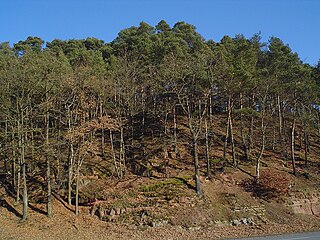 W
WForest degradation is a process in which the biological wealth of a forest area is permanently diminished by some factor or by a combination of factors. "This does not involve a reduction of the forest area, but rather a quality decrease in its condition."The forest is still there, but with fewer trees, or less species of trees, plants or animals, or some of them affected by plagues. This degradation makes the forest less valuable and may lead to deforestation. Forest degradation is a type of the more general issue of land degradation. Deforestation and forest degradation continue to take place at alarming rates, which contributes significantly to the ongoing loss of biodiversity.
 W
WThe forest floor, also called detritus, duff and the O horizon, is one of the most distinctive features of a forest ecosystem. It mainly consists of shed vegetative parts, such as leaves, branches, bark, and stems, existing in various stages of decomposition above the soil surface. Although principally composed of non-living organic material, the forest floor also teems with a wide variety of fauna and flora. It is one of the richest components of the ecosystem from the standpoint of biodiversity because of the large number of decomposers and predators present, mostly belonging to invertebrates, fungi, algae, bacteria, and archaea. Certain (adapted) plants may be more apparent in tropical forests, where rates of metabolism and species diversity are much higher than in colder climates.
 W
WForest floor interception is the part of the (net) precipitation or throughfall that is temporarily stored in the top layer of the forest floor and successively evaporated within a few hours or days during and after the rainfall event. The forest floor can consist of bare soil, short vegetation or litter.
 W
WA fuel ladder or ladder fuel is a firefighting term for live or dead vegetation that allows a fire to climb up from the landscape or forest floor into the tree canopy. Common ladder fuels include tall grasses, shrubs, and tree branches, both living and dead. The removal of fuel ladders is part of defensible space 'firescaping' practices.
 W
WInterception refers to precipitation that does not reach the soil, but is instead intercepted by the leaves, branches of plants and the forest floor. It occurs in the canopy, and in the forest floor or litter layer. Because of evaporation, interception of liquid water generally leads to loss of that precipitation for the drainage basin, except for cases such as fog interception, but increase flood protection dramatically, Alila et al., (2009).
 W
WKrummholz or krumholtz — also called knieholz — is a type of stunted, deformed vegetation encountered in the subarctic and subalpine tree line landscapes, shaped by continual exposure to fierce, freezing winds. Under these conditions, trees can only survive where they are sheltered by rock formations or snow cover. As the lower portion of these trees continues to grow, the coverage becomes extremely dense near the ground. In Newfoundland and Labrador, the formation is known as tuckamore. Krummholz trees are also found on beaches such as the Oregon coast, where trees can become much taller than their subalpine cousins.
 W
WLarge woody debris (LWD) are the logs, sticks, branches, and other wood that falls into streams and rivers. This debris can influence the flow and the shape of the stream channel. Large woody debris, grains, and the shape of the bed of the stream are the three main providers of flow resistance, and are thus, a major influence on the shape of the stream channel. Some stream channels have less LWD than they would naturally because of removal by watershed managers for flood control and aesthetic reasons.
 W
WLaurel forest, also called laurisilva or laurissilva, is a type of subtropical forest found in areas with high humidity and relatively stable, mild temperatures. The forest is characterized by broadleaf tree species with evergreen, glossy and elongated leaves, known as "laurophyll" or "lauroid". Plants from the laurel family (Lauraceae) may or may not be present, depending on the location.
 W
WIn ecology, a light gap is a break in forest canopy or similar barrier that allows young plants to grow where they would be otherwise inhibited by the lack of light reaching the seedbed. Light gaps form predominantly when a tree falls, and thus produces an opening in the forest canopy. Light gaps are important for maintaining diversity in species-rich ecosystems.
 W
WThe world's superlative trees can be ranked by any factor. Records have been kept for trees with superlative height, trunk diameter or girth, canopy coverage, airspace volume, wood volume, estimated mass, and age.
 W
WSweden's superlative trees have been ranked by various factors. Records have been kept for trees with superlative height, wood volume, age, and stoutness. This last one means trunk diameter or girth.
 W
WA living stump is created when a live tree is cut, burned, eaten, or infected, causing its cambium to die above the root system. Stumps are generally characterized as having a thin outer layer of living cells that surround a hollow central cavity. Living stumps can survive for several years by root grafting to the root system of living trees and using excess carbon reserves. Root grafting allows for carbon transfer from living trees to living stumps resulting in incremental cambium growth in the stump. Stumps can grow a callus tissue over its cross section which prolongs longevity of the stump by protecting it from infection and insect damage. A living stump which is capable of producing sprouts or cuttings is known as a stool, and is used in the coppicing method of woodland management.
 W
WMontane ecosystems are found on the slopes of mountains. The alpine climate in these regions strongly affect the ecosystem because temperatures fall as elevation increases, causing the ecosystem to stratify. Dense montane forests are common at moderate elevations, due to moderate temperatures and high rainfall. At higher elevations, the climate is harsher, with lower temperatures and higher winds, preventing the growth of trees and causing the plant community to transition to montane grasslands, shrublands or alpine tundra.
 W
WNalini Nadkarni is an American ecologist who pioneered the study of Costa Rican rain forest canopies. Using mountain climbing equipment to make her ascent, Nadkarni first took an inventory of the canopy in 1981, followed by two more inventories in 1984.
 W
WNatural beech wood is a beech wood, that is able to replenish and sustain itself on its own.
 W
WThe northern hardwood forest is a general type of North American forest ecosystem found over much of southeastern and south central Canada, Ontario and Quebec, extending south into the United States in northern New England, New York, and Pennsylvania, and west along the Great Lakes to Minnesota and western Ontario. Some ecologists consider it a transitional forest because it contains species common to both the oak-hickory forest community to the south and the Boreal forest community to the north. The trees and shrub species of the Northern Hardwood Forest are known for their brilliant fall colors, making the regions that contain this forest type popular fall foliage tourist destinations.
 W
WA nurse tree is a larger, faster-growing tree that shelters a small, slower-growing tree or plant. The nurse tree can provide shade, shelter from wind, or protection from animals who would feed on the smaller plant.
 W
WAn oak forest is a plant community with a tree canopy dominated by oaks. In terms of canopy closure, oak forests contain the most closed canopy, compared to oak savannas and oak woodlands.
 W
WAn oak woodland is a plant community with a tree canopy dominated by oaks. In terms of canopy closure, oak woodlands are intermediate between oak savanna, which is more open, and oak forest, which is more closed. Although the community is named for the dominance of oak trees, the understory vegetation is often diverse and includes many species of grasses, sedges, forbs, ferns, shrubs, and other plants.
 W
WPine barrens, pine plains, sand plains, or pinelands occur throughout the U.S. from Florida to Maine as well as the Midwest, West, and Canada and parts of Eurasia. Pine barrens are plant communities that occur on dry, acidic, infertile soils, dominated by grasses, forbs, low shrubs, and small to medium-sized pines. The most extensive barrens occur in large areas of sandy glacial deposits, lakebeds, and outwash terraces along rivers.
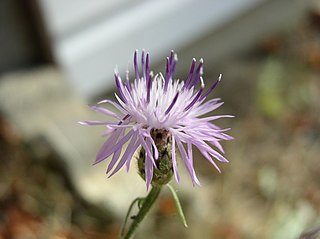 W
WThe pioneer species are hardy species which are the first to colonize barren environments or previously biodiverse steady-state ecosystems that have been disrupted, such as by fire. Some lichens grow on rocks without soil, so may be among the first of life forms, and break down the rocks into soil for plants. Since some uncolonized land may have thin, poor quality soils with few nutrients, pioneer species are often hardy plants with adaptations such as long roots, root nodes containing nitrogen-fixing bacteria, and leaves that employ transpiration. Note that they are often photosynthetic plants, as no other source of energy except light energy is often available in the early stages of succession, thus making it less likely for a pioneer species to be non-photosynthetic. The plants that are often pioneer species also tend to be wind-pollinated rather than insect-pollinated, as insects are unlikely to be present in the usually barren conditions in which pioneer species grow; however, pioneer species tend to reproduce asexually altogether, as the extreme or barren conditions present make it more favourable to reproduce asexually in order to increase reproductive success rather than invest energy into sexual reproduction. Pioneer species will die creating plant litter, and break down as "leaf mold" after some time, making new soil for secondary succession, and nutrients for small fish and aquatic plants in adjacent bodies of water.
 W
WRainforests are forests characterized by high and continuous rainfall, with annual rainfall in the case of tropical rainforests between 2.5 and 4.5 metres and definitions varying by region for temperate rainforests. The monsoon trough, alternatively known as the intertropical convergence zone, plays a significant role in creating the climatic conditions necessary for the Earth's tropical rainforests: which are distinct from monsoonal areas of seasonal tropical forest.
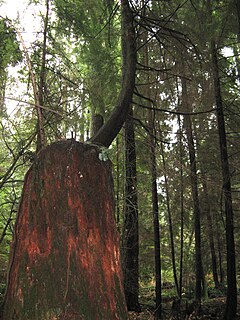 W
WA secondary forest is a forest or woodland area which has re-grown after a timber harvest, until a long enough period has passed so that the effects of the disturbance are no longer evident. It is distinguished from an old-growth forest, which has not recently undergone such disruption, and complex early seral forest, as well as third-growth forests that result from harvest in second growth forests. Secondary forest regrowing after timber harvest differs from forest regrowing after natural disturbances such as fire, insect infestation, or windthrow because the dead trees remain to provide nutrients, structure, and water retention after natural disturbances. However, often after natural disturbance the timber is harvested and removed from the system, in which case the system more closely resembles secondary forest rather than complex early seral forest.
 W
WSecondary succession is one of the two types ecological succession of a plants life. As opposed to the first, primary succession, secondary succession is a process started by an event that reduces an already established ecosystem to a smaller population of species, and as such secondary succession occurs on preexisting soil whereas primary succession usually occurs in a place lacking soil. Many factors can affect secondary succession, such as trophic interaction, initial composition, and competition-colonization trade-offs. The factors that control the increase in abundance of a species during succession may be determined mainly by seed production and dispersal, micro climate; landscape structure ; bulk density, pH, and soil texture.
 W
WSeed trees are trees left after reproduction cutting to provide seeds for natural regeneration in the seed-tree method. These trees serve as both the gene source for the new crop of regeneration and as a source of timber during future cuttings. Because of its importance, a seed tree should be carefully chosen based upon both economic and biological factors. Selected seed trees should be the desired species, phenotypically superior, prolific in seeding and flowering, sturdy and healthy, free of damage, and of good growth form.
 W
WIn ecology, shade tolerance refers to a plant's ability to tolerate low light levels. The term is also used in horticulture and landscaping, although in this context its use is sometimes imprecise, especially in labeling of plants for sale in commercial nurseries.
 W
WIn forest ecology, a snag refers to a standing, dead or dying tree, often missing a top or most of the smaller branches. In freshwater ecology it refers to trees, branches, and other pieces of naturally occurring wood found sunken in rivers and streams; it is also known as coarse woody debris. When used in manufacturing, especially in Scandinavia, they are often called "dead wood" and in Finland "kelo wood".
 W
WSods is a term used in the Allegheny Mountains of eastern West Virginia for a mountain top meadow or bog, in an area that is otherwise generally forested. The term is similar to that of a "grass bald", a more widespread designation applied throughout the central and southern Appalachian region.
 W
WIn hydrology, stemflow is the flow of intercepted water down the trunk or stem of a plant. Stemflow, along with throughfall, is responsible for the transferral of precipitation and nutrients from the canopy to the soil. In tropical rainforests, where this kind of flow can be substantial, erosion gullies can form at the base of the trunk. However, in more temperate climates stemflow levels are low and have little erosional power.
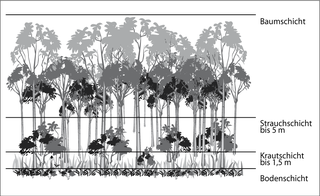 W
WStratification in the field of ecology refers to the vertical layering of a habitat; the arrangement of vegetation in layers. It classifies the layers of vegetation largely according to the different heights to which their plants grow. The individual layers are inhabited by different animal and plant communities (stratozones).
 W
WA swamp is a forested wetland. Swamps are considered to be transition zones because both land and water play a role in creating this environment. Swamps vary in size and are located all around the world. The water of a swamp may be fresh water, brackish water, or seawater. Freshwater swamps form along large rivers or lakes where they are critically dependent upon rainwater and seasonal flooding to maintain natural water level fluctuations. Saltwater swamps are found along tropical and subtropical coastlines. Some swamps have hammocks, or dry-land protrusions, covered by aquatic vegetation, or vegetation that tolerates periodic inundation or soil saturation. The two main types of swamp are "true" or swamp forests and "transitional" or shrub swamps. In the boreal regions of Canada, the word swamp is colloquially used for what is more correctly termed a bog, fen, or muskeg. Some of the world's largest swamps are found along major rivers such as the Amazon, the Mississippi, and the Congo.
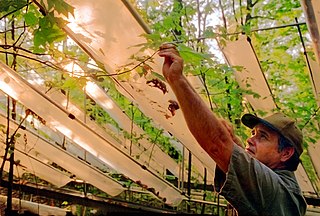 W
WIn Hydrology, throughfall is the process which describes how wet leaves shed excess water onto the ground surface. These drops have greater erosive power because they are heavier than rain drops. Furthermore, where there is a high canopy, falling drops may reach terminal velocity, about 8 metres (26 ft), thus maximizing the drop's erosive potential.
 W
WIn botany, a tree is a perennial plant with an elongated stem, or trunk, supporting branches and leaves in most species. In some usages, the definition of a tree may be narrower, including only woody plants with secondary growth, plants that are usable as lumber or plants above a specified height. In wider definitions, the taller palms, tree ferns, bananas, and bamboos are also trees. Trees are not a taxonomic group but include a variety of plant species that have independently evolved a trunk and branches as a way to tower above other plants to compete for sunlight. Trees tend to be long-lived, some reaching several thousand years old. Trees have been in existence for 370 million years. It is estimated that there are some three trillion mature trees in the world.
 W
WThe tree line is the edge of the habitat at which trees are capable of growing. It is found at high elevations and high latitudes. Beyond the tree line, trees cannot tolerate the environmental conditions. The tree line is sometimes distinguished from a lower timberline or forest line, which is the line below which trees form a forest with a closed canopy.
 W
WAfter a tree has been cut and felled, the stump or tree stump is usually a small remaining portion of the trunk with the roots still in the ground. Stumps may show the age-defining rings of a tree. The study of these rings is known as dendrochronology.
 W
WA treefall gap is a distinguishable hole in a forest with vertical sides extending through all levels down to an average height of 2 m (6.6 ft) above ground. These holes occur as result of a fallen tree or large limb. The ecologist who developed this definition used two meters because believed that "a regrowth height of 2 m was sufficient" for a gap to be considered closed, but not all scientists agreed. For example, Runkle believed that regrowth should be 10–20 m (33–66 ft) above the ground. Alternatively, a treefall gap as "the smallest gap [that must] be readily distinguishable amid the complexity of forest structure."
 W
WIn forestry and ecology, understory, or understorey, also known as underbrush or undergrowth, comprises plant life growing beneath the forest canopy without penetrating it to any great extent, but above the forest floor. Only a small percentage of light penetrates the canopy so understory vegetation is generally shade-tolerant. The understory typically consists of trees stunted through lack of light, other small trees with low light requirements, saplings, shrubs, vines and undergrowth. Small trees such as holly and dogwood are understory specialists.
 W
WA veteran tree or legacy tree is a tree which, because of its great age, size or condition, is of exceptional cultural, landscape or nature conservation value.
 W
WA wet woodland is a type of plant community. It is a biodiversity habitat in the United Kingdom as part of the British National Vegetation Classification system.
 W
WIn forestry, windthrow refers to trees uprooted by wind. Breakage of the tree bole (trunk) instead of uprooting is called windsnap. Blowdown refers to both windthrow and windsnap.
 W
WA woodland edge or forest edge is the transition zone (ecotone) from an area of woodland or forest to fields or other open spaces. Certain species of plants and animals are adapted to the forest edge, and these species are often more familiar to humans than species only found deeper within forests. A classic example of a forest edge species is the white-tailed deer in North America.
 W
WYatir Forest is a forest in Israel, located on the southern slopes of Mount Hebron, on the edge of the Negev Desert. The forest covers an area of 30,000 dunams, and is the largest planted forest in Israel.